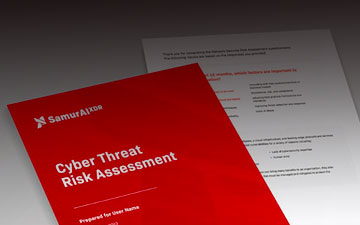Implementing robust cybersecurity measures is essential for companies of all sizes. The ever-evolving threat landscape is becoming more dangerous with the emergence of sophisticated techniques designed to enable cybercriminals to compromise a company’s IT environment. The combination of more sophisticated threats and an increased attack surface provided by a remote workforce with mobile endpoints have significantly decreased the viability of traditional cybersecurity solutions.
Organizations of all sizes have increased their reliance on digital technology to address the needs of a remote workforce and streamline business operations. As companies embrace digital technology, their exposure and risk is transferred from the physical to the digital world. This transformation requires a different approach to cybersecurity that focuses on protecting valuable data that threat actors may be interested in stealing or compromising.
The issue of securing digital assets affects businesses in all market sectors. For instance, companies operating in real estate collect, store, and process large amounts of information on clients including data to verify identity, credit records, and payment details. Threat actors who successfully compromise this data put the company and the individuals whose data is affected at risk. Clients are at risk of identity theft and the company will incur reputational damage that can potentially drive them out of business.
Extended detection and response (XDR) is an approach to cybersecurity that takes a holistic view of a company’s computing environment to provide enhanced visibility into potential threats from across the complete infrastructure. XDR incorporates functionality that complements existing network and endpoint security to identify threats that escape detection from other cybersecurity solutions.
XDR is designed to improve the cybersecurity of businesses of any size. Large and small companies have valuable data resources that present attractive targets for threat actors and cybercriminals. For several reasons, small businesses may be more prone to cyberattacks than larger corporations. These reasons include a lack of security resources and a misguided belief that they are not at risk. Some small businesses think that they do not need to be concerned because larger companies make better targets for threat actors. They may also have only recently begun digital transformation and not have experience protecting their assets.
Over half of affected small businesses end up closing in the wake of a breach. Small and medium-size businesses need to address their cybersecurity issues and implement more effective methods of protecting their IT environment and its valuable data. The threats they face are similar to those of large corporations. Failure to take the appropriate steps to improve cybersecurity risks losing the business.
Why Small Businesses are Targets for Threat Actors
At one time, small businesses may have been correct to assume that they were not high on threat actors’ lists of tempting targets. Cybercriminals did not want to waste their time launching attacks that did not present the opportunity to compromise valuable information which could be used to extort victims for financial gain. Corporations such as banks or metropolitan health networks that processed large volumes of sensitive information were more likely to be targeted than small businesses in the past. This is no longer the case.
Small businesses today rely heavily on their IT environments in many ways that make them even more attractive as targets for threat actors. Rather than attempting to subvert the multi-layered security of a large corporation with a high degree of security awareness, cybercriminals go after the low-hanging fruit available from small businesses. At the same time the tools of the trade of threat actors have become much more accessible with malware becoming available as a service.
The digital transformation of small businesses has made them equally appealing to threat actors. This transformation involves the conversion of information into a digital format that is stored and processed by a company’s IT environment. Many small businesses have embraced digital transformation as a method of remaining competitive, supporting a mobile workforce, and providing a satisfactory customer experience. This creates valuable data assets that need to be readily available for customers and protected from cyberthreats.
Disruption to the IT environment of small businesses cannot be tolerated. Ecommerce sites need to be available for customers and internal systems are required to maintain operations and run the business. Effectively addressing the digital estates of small companies requires a robust and advanced security posture.
Issues with the Security Posture of Small Businesses
Unfortunately, in many cases, the awareness and attention paid to cybersecurity risks have not kept pace with the digital transformation of small businesses. While the risks of a cyberattack are steadily increasing, companies have often not maintained an effective level of security to address the new threats.
Several related factors may contribute to the ineffective security posture of a small business.
Unawareness of emerging threats
Small businesses with limited technical resources to devote to cybersecurity may not be aware of the emerging threats to their environments. An important aspect of security that needs to be addressed is the additional attack surface presented by the endpoints deployed to support a mobile workforce. Each endpoint presents an entry point into company systems that can be exploited by cybercriminals.
Cyberthreats are evolving at a phenomenal rate that cannot effectively be addressed by endpoint antivirus tools. Threats such as ransomware will continue to rapidly evolve as threat actors search for new ways to compromise a company’s valuable data.
Unfamiliarity with sophisticated attack methods
In addition to not developing an understanding of new types of threats, small companies may also be unfamiliar with the sophisticated methods used to launch cyberattacks. Advanced persistent threats (APTs) constitute a very dangerous class of cyberthreats that can be very difficult to detect due to the weak signals generated by different components of the threat. An APT can remain resident and perform malicious activities in an IT environment for an extended time, causing extensive damage to a business.
Reliance on traditional cybersecurity solutions
Small businesses may rely too heavily on traditional and legacy security solutions that are not effective against new types of threats and delivery techniques. Traditional security platforms are insufficient for several reasons.
- Firewalls and antivirus software only protects against known threats;
- The weak signals generated by APTs cannot be detected;
- False positive alarms can lead to alert overload, stress on security personnel, and diminished effectiveness of cybersecurity solutions.
How XDR Improves Cybersecurity
An XDR solution improves cybersecurity and provides small and large organizations with the necessary tools to detect sophisticated and previously unidentified threats. Companies of any size can enjoy the following benefits from the addition of an XDR solution to their existing security stack.
- XDR complements existing solutions through the addition of behavior-based detections, behavior modeling, and advanced analytics.
- Reducing false positives with XDR reduces the strain on security personnel and allows them to concentrate on value-added tasks.
- XDR prioritizes threats so security personnel are only presented with the issues that warrant attention.
- XDR’s ability to provide security incident automation enables response procedures to be streamlined and consistent.
- XDR unifies alerting and telemetry from all sources in the organization to provide enhanced visibility into the environment.
- Cross-domain correlation, where analysis is performed on all collected telemetry, is instrumental in XDR’s ability to detect the weak signals that may indicate the presence of an APT or other stealthy threat.
Implement an Advanced XDR Solution
Samurai XDR provides businesses of all sizes with a cloud-based solution designed to enhance cybersecurity. Samurai’s solution promotes reactive and proactive threat hunting to mitigate security breaches and identify them before they affect the environment.
Sign up for a 30 day free trial to see the powerful threat detection and response capabilities of Samurai XDR. Talk to the experts at Samurai and learn how your small or large business can improve its cybersecurity posture with Samurai XDR.
Featured articles
Identity Management in the Physical and Digital Worlds
7 August 2024 | Webinars
In today's rapidly evolving world, managing identities securely and efficiently is more crucial than ever. Join us for an insightful...
Identity Management in the Physical and Digital Worlds
30 July 2024 | Webinars
In today's rapidly evolving world, managing identities securely and efficiently is more crucial than ever. Join us for an insightful...
XDR for Small and Medium Businesses: Is It Worth It?
24 July 2024 | XDR
Cybersecurity is of paramount importance to virtually all organizations and SMBs have to address several specific challenges. The failure to...





